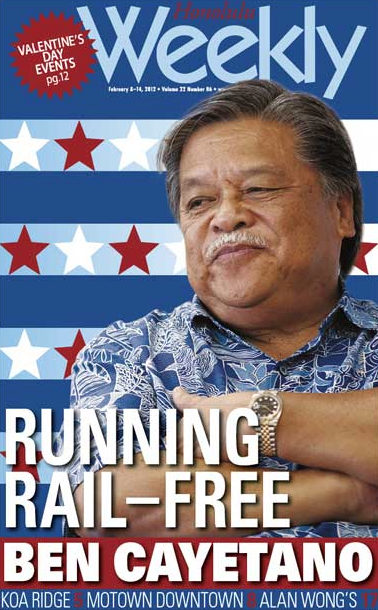However controversial a rail project is, is it a good idea to pull the plug after construction has already begun? Honolulu residents have that question to ponder from now until Election Day.

The city’s mayoral election has become a referendum on its controversial rail project. Former Gov. Ben Cayetano came out of retirement (and took a demotion) to save the city from building a light rail system in Oahu, passing through downtown, the airport, the state’s largest shopping center, and the proposed site of a new University of Hawaii campus. Pillars for the elevated track have already been built.
If Cayetano had won 50 percent of the vote in the August non-partisan primary, the race would be over. His 44 percent is still a formidable hurdle for challenger Kirk Caldwell, a former state legislator who briefly served as acting mayor when the sitting mayor resigned to run for governor. Caldwell lost the job to Peter Carlisle, another rail supporter, in a 2010 special election.
Caldwell did better than Carlisle this August, garnering 29 percent to Carlisle’s 25 percent, meaning that he will be the one to face Cayetano in the run-off. Though he won’t continue in the office, Carlisle pledged, "As mayor for the next four months, I'm going to do everything I can to get rail far enough along so that it cannot possibly be stopped."
If Caldwell can win over the great majority of Carlisle voters, he could be victorious next month. Besides, August's primary isn’t necessarily a precise indicator of how the general election could go, since turnout will likely be far higher in November.
Cayetano is a named plaintiff in an anti-rail lawsuit, which charges that the city “did not adequately consider viable transportation alternatives” and “decided to conduct the archeological inventory in four phases, rather than surveying the entire 20-mile route before starting the project.”
Cayetano’s counter-proposal includes bus rapid transit and new road capacity, including elevated express roadways and shorter bypasses. His platform's tagline says it all: "It's time to get our city on the road to a better future" [italics added]. Cayetano says his plan would cost about 20 percent as much as the light rail system, and that it would take just six months to build (as opposed to 10 years for rail). But critics say it isn’t a sustainable solution to Honolulu’s traffic woes.
While it’s hard to see the election through anything but a prism of the transit controversy, both candidates deny that it’s the only issue in the campaign. Cayetano says it’s about much more, while Caldwell, unfortunately, says it’s about much less.
At his campaign headquarters on the night of the primary election, Cayetano told a crowd of jubilant supporters, “This campaign is not about rail, this campaign is bigger than that. It's about power, it's about giving the people a voice as required in any democracy. This is what it's all about."
Compare those visionary lines with Caldwell’s claim, in an interview with Honolulu Magazine, that what he loved about being mayor was “dealing with things like taking away garbage, dealing with sewage, filling potholes, making sure your water comes on … making sure the grass is cut in the parks, bathrooms are clean in the public restrooms, all of those things. I love that stuff.” As for “legacy issues,” he named modernization of the sewer infrastructure. Even the rail system’s biggest supporter knows it’s a political hot potato. Fifty percent of Oahu residents would vote now to stop the rail project, according to a recent poll. When the rail project was approved by voters in 2008, it only won with 53 percent of the vote.
Several problems have dogged the light rail project. Cost, as always, is one, although it’s being paid for with an already-approved excise tax, one-third of which will be covered by tourists, Caldwell says. Some voters also worry the elevated rail line will mar the cityscape.
Another, thornier issue is that of burial grounds. Hawaii state law prohibits removing, destroying or altering any burial sites unless explicitly permitted by state and local burial councils. As suspected, archaeologists did find a bone along the proposed path of the rail line last month.
According to the AP, “It's important in Hawaiian culture to leave bones undisturbed because of the belief that people infuse their life force into the ground once they are buried. Since this process isn't finished until the bones have dissolved, digging them up interrupts a person's journey in the afterlife.”
At least two major burial sites along the route were already known about before the excavation. Cayetano warned that the city’s promise to re-route the line around any sites they might find was disingenuous. "They're going to talk to the burial council and say, 'Where can we put these bones, because we're not going to move this column because it's too expensive,’” Cayetano said.
We’ll be bringing you more news about how transportation figures into the November 6 elections at the national and local levels. Got a hot contest in your area? Make sure we know about it – send us a note at tips@usa.streetsblog.org.





